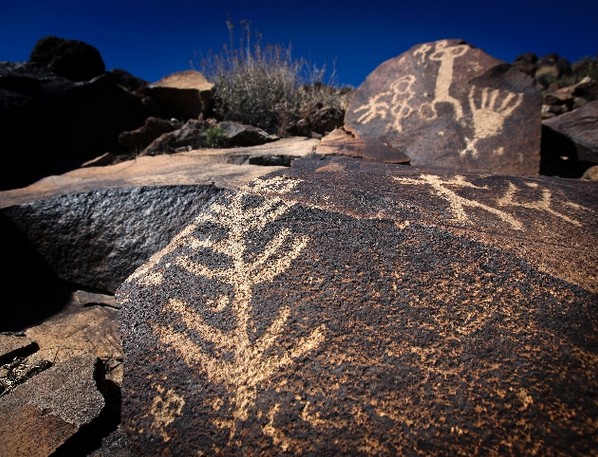Sloan Canyon National Conservation Area
Introduction
Text-to-speech Audio
Images
Sloan Canyon petroglyph. (Photograph, Bureau of Land Management)

Sloan Canyon petroglyphs. (Photograph, Las Vegas Review Journal)

Backstory and Context
Text-to-speech Audio
The Black rock of Sloan Canyon is evidence of volcanic activity 13 million years ago. The Black volcanic rock was the perfect canvas. There are 318 petroglyph, or rock art panels and 1,700 individual design elements documented in Sloan Canyon, created by the first Nevadans thousands of years ago. It is considered one of the most significant cultural resources in Southern Nevada.
Hiking and horseback riding are allowed and this is the best way to see this unique ecosystem and heritage site. Remember it can get hot in the Mojave Desert! Bring water. Stay on the trails and roads, and leave the rest of the desert to the rattlesnakes. Help protect this ancient Nevada heritage site by leaving only your footprints.
Sources
Brean, Henry. "New visitor center planned at Sloan Canyon area in Henderson." Las Vegas Review Journal(Las Vegas)December 01, 2018. . https://www.reviewjournal.com/local/henderson/new-visitor-center-planned-at-sloan-canyon-area-in-henderson-1540192/
Sloan Canyon National Conservation Area. Nevada Rock Art Foundation / Bradshaw Foundation. . Accessed June 22, 2019. http://www.bradshawfoundation.com/nevada/sloan_canyon.php.
Programs: National Conservation Lands: Nevada: Sloan Canyon National Conservation Area: Geology. Bureau of Land Management. . Accessed June 22, 2019. https://www.blm.gov/basic/nevada-sloan-canyon-geology-tab.
BLM 100 Trail (Petroglyph Canyon Trail). Bird and Hike. . Accessed June 23, 2019. www.birdandhike.com.
Friends of Sloan Canyon. . Accessed June 23, 2019. https://friendsofsloan.org/.
Sloan Canyon Petroglyphs. Bureau of Land Management. . Accessed June 23, 2019. https://www.blm.gov/visit/sloan-canyon-petroglyphs.
